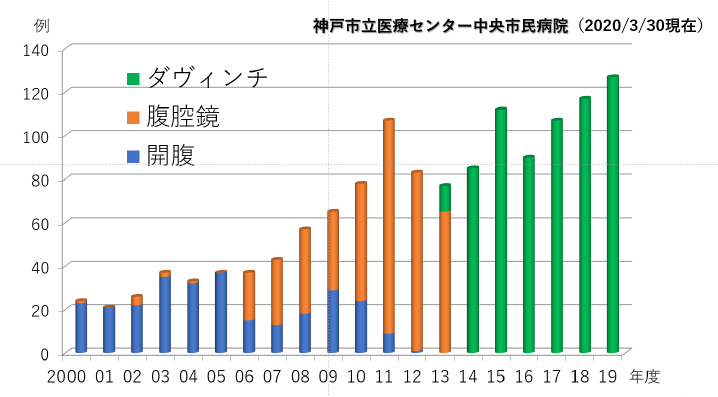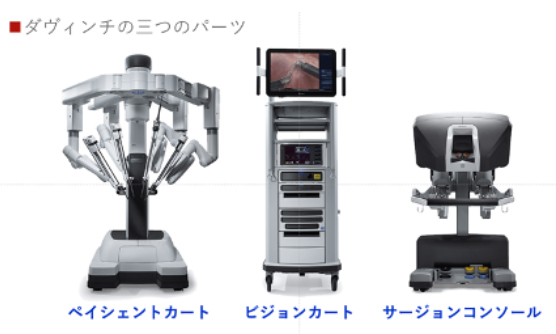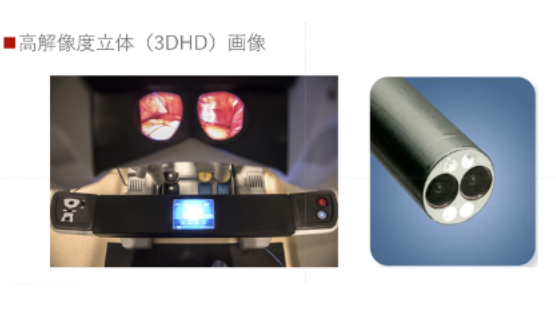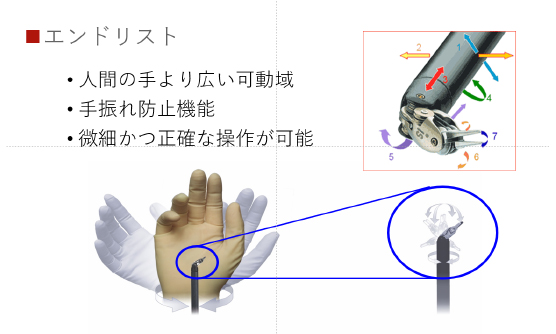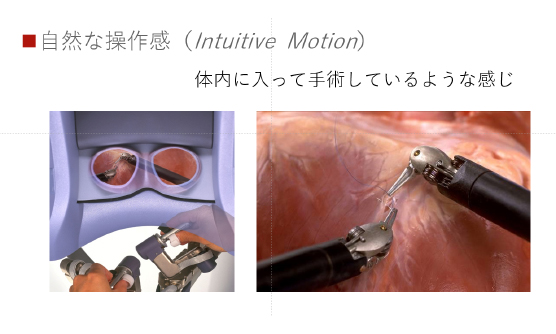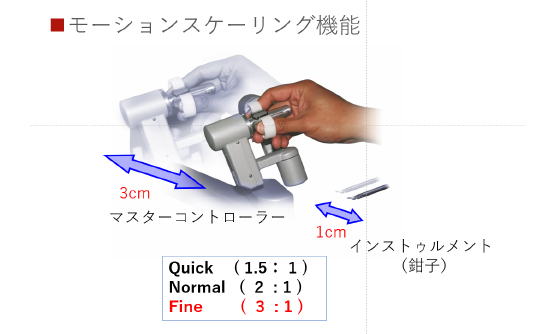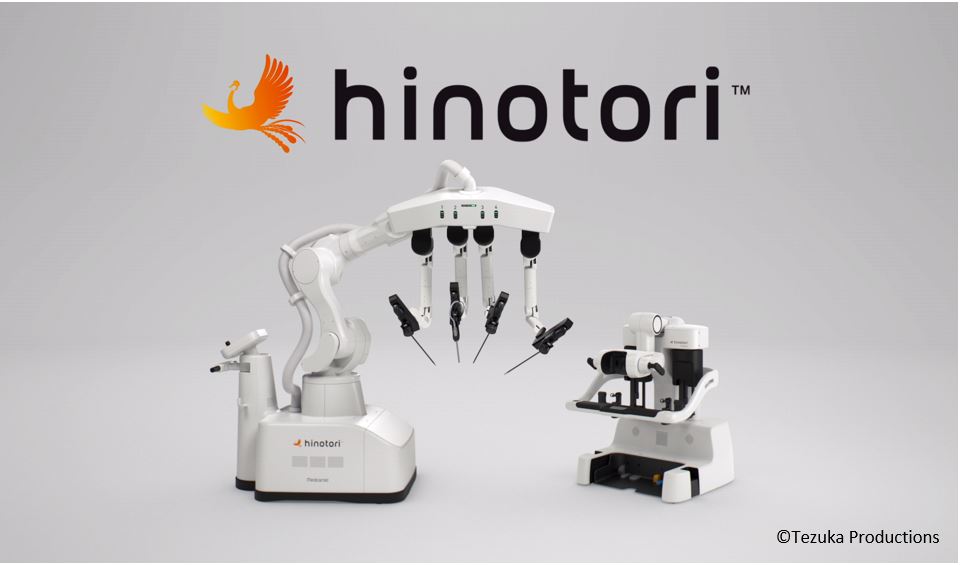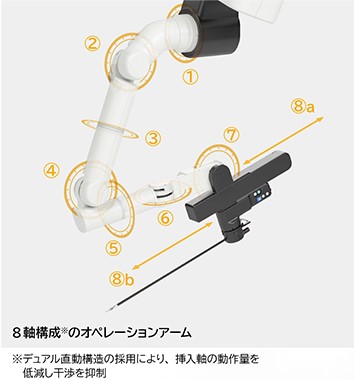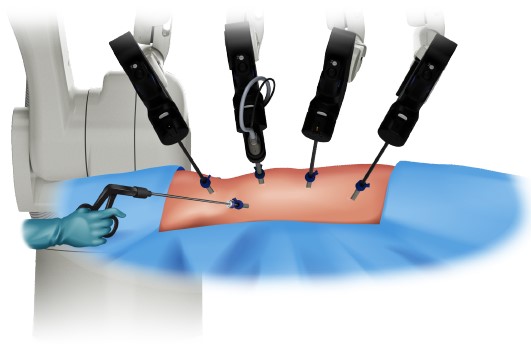ロボット手術センター
世界的に日常診療のひとつとなったロボット手術は、日本では平成26年に泌尿器科領域で前立腺がんに対し保険診療がはじまりました。ここでのロボット手術は、従来の腹腔鏡・胸腔鏡にロボットを装着して行う手術のことです。創が小さくて、さらに腹腔鏡では炭酸ガスによる気腹の圧力によって出血が少ないという利点に加えて、拡大、立体視ができ、自由に動く鉗子によって細かい操作ができます。術者は遠隔操作により、カメラと3本の腕をひとりで自由自在に動かすことができます。当院では、平成26年1月にダヴィンチSiを使ったロボット支援手術を開始しました。令和元年8月にはダ・ヴィンチXiを新規導入し2台体制となり、同年11月にはSiをXに機種変更し、ダ・ヴィンチXiとXの2台で診療を行っております。
2年ごとの診療報酬改定において、平成28年には腎がんの腎部分切除術、平成30年には心臓弁形成術、縦隔腫瘍、肺がん、食道がん、胃がん、直腸がん、膀胱がん、子宮体がん、子宮筋腫などの良性子宮腫瘍、令和2年には、胸腺摘除、膵臓がん、腎盂形成術、骨盤臓器脱手術に適用され、心臓血管外科、呼吸器外科、消化器外科、婦人科など多くの診療科の術式でロボット手術が承認されました。当院では平成29年5月にロボット手術センターを新設し、耳鼻咽喉科、胸部外科、消化器外科、泌尿器科、産婦人科領域など、今後のさらなる広がりを見据えてロボット手術の拡充を図るとともに、看護部、ME、事務なども含め関係部署の連携・調整体制を強化しております。
新規術式を導入するには、ロボット手術認定医の育成、複数回にわたって指導医(プロクター)を招聘して手術の導入、認定施設取得のための症例数の確保が必要です。認定医取得のためには、個々の医師が、シミュレーターを使用した練習、動物でのトレーニング、教育指定施設での手術見学が義務付けられております。また認定施設取得前には病院による一部費用負担が生じます。
そして最も重要なのが、安全に新規術式導入を行うことにあります。手術を受ける患者さんに重大な危険が及ぶことのないよう、関係部署が緊密に連携をとり、導入前にシミュレーションを繰り返し行い、手術前後で疑問点、不備なところを洗い出し解決しながら、円滑な導入ができるように手助けすることがこのセンターの使命であります。
手術支援ロボット Da Vinci
ロボット手術センターの概要・構成診療科
当センターの構成診療科と対象手術、手術概要を表1に示します。
表1
| 構成診療科 | 対象手術 | 備考 |
| 泌尿器科 |
|
通常の保険診療として平成26年より前立腺がん、平成28年より腎がん、平成30年より膀胱がん、令和2年より腎盂形成術を実施しています。 令和2年より骨盤臓器脱(4例まで)に対し手術料のみ病院負担で開始しています。 前立腺がん 649例 腎がん 220例 膀胱がん 40例 (令和2年3月現在) |
|---|---|---|
| 外科 |
|
胃がん:平成30年6月より保険診療として実施しています。 食道がん・直腸がん:平成30年10月より保険診療として実施しています。 |
| 産婦人科 |
|
早期子宮体がん:平成30年10月より保険診療として実施しています。 |
| 耳鼻咽喉科 |
|
順次対応していきます。 |
| 呼吸器外科 |
|
順次対応していきます。 |
| 心臓血管外科 |
|
手術申請の条件は満たしており申請準備中。今年中に開始できる見込み |
当院におけるロボット支援(ダヴィンチ)手術
泌尿器科
当院泌尿器科ではこれまで400例を超える腹腔鏡下根治的前立腺全摘除術を行ってきました。この経験を生かして平成26年1月のダヴィンチ手術1例目の導入は、全く問題なく順調でした。令和2年4月にロボット支援根治的前立腺全摘除術650例に達し、引き続き制癌と機能温存の向上を目指したいと思っております(図1)。また腎癌の部分切除術も保険適用前の平成27年2月に開始し、令和2年3月までに220例施行しました。三次元の視野に加え、繊細な動きのできるハサミでの切開と縫合操作の容易さから、腹腔鏡に比べ腎動脈を阻血する時間は短縮され、術後の腎機能温存も有意に向上しています。保険適用開始前から始めた膀胱全摘除術も40例に施行しております。令和2年4月より腎盂形成術と仙骨膣固定術も開始しました。
外科
当院では、胃癌に関しては2018年6月から、食道癌と直腸癌に関しては2018年10月から保険診療として行っています。ダヴィンチ手術自体は通常の腹腔鏡手術や胸腔鏡手術と同等の手術費用で可能となっており、患者様に負担していただく費用(自己負担限度額)は、高額医療費制度が適応されます。詳細は下記をご確認ください。
厚生労働省 高額療養費制度を利用される皆さまへ現在は、食道癌はほぼ全例がダヴィンチ手術で施行されており、胃癌や直腸癌も腹腔鏡手術の中でダヴィンチ手術の占める割合が年々増えてきています。胃癌に関しては幽門側胃切除術や胃全摘術だけでなく機能温存すべく(胃をできるだけ残すために)噴門側胃切除術も行っています。直腸癌に関しては根治性を保ちつつ神経温存によって排尿排便機能の低下を出来るだけ避けるような術後QOL(quality of life)を意識した手術を行っています。
それぞれの臓器や疾患についてダヴィンチ手術に関連したご質問等ございましたら、気軽に外科外来までご相談ください。臓器毎に主とした専門医がいますので適宜対応させていただきます。
婦人科
婦人科悪性腫瘍(子宮がんや卵巣がんなど)に対する腹腔鏡下手術は、初期子宮体癌に対して平成26年に保険適応となり、当院ではこれまで200例以上に対して腹腔鏡下子宮体癌根治手術を行ってきました。腹腔鏡手術は開腹手術に比較して患者さんにとって低侵襲(=体への負担が少ない)で、術後の痛みが少なく回復が早いことが特長です。ロボット支援(ダヴィンチ)手術は腹腔鏡手術の延長上に位置付けられ同様に低侵襲ですが、腹腔鏡手術と異なりロボットの鉗子は360度動かすことが可能で、また高解像度の3D画像で手術を行うことができるため、狭い骨盤内でより緻密で丁寧な手術が可能になります。
初期子宮体癌に対するロボット支援(ダヴィンチ)手術は、平成30年4月に保険適用となりました。当院では平成30年4月から本手術を導入し令和2年3月までに約40人の患者さんにこの手術を行って、患者さんのより良い術後生活に貢献しています。また令和元年に導入された新機種のXi, Xでは、これまで以上に低侵襲でかつ多くの患者さんに適しており、我々にとっても扱いやすくなっています。
心臓血管外科
当科では以前より僧帽弁閉鎖不全症に対する右小開胸での僧帽弁形成術を行っています。最近は完全内視鏡下ですべての手技を行っており、ロボット手術と全く変わらない皮膚切開でのアプローチが可能となっています。ロボットの申請条件はすべて満たしており、今年中に申請と開始を行えるように準備中です。より多くの患者さんに我々の経験を生かした質の高いロボット手術をご提供できることになると思います。
ロボット支援(ダヴィンチ)手術の特徴(表1、2)
ダヴィンチはその三次元の拡大視野と操作性に優れ、腹腔鏡による気腹圧で出血量が少なく、回復がはやいという利点があります。一方で、機器本体や鉗子類のコストが高く、触覚がない、緊急時の対応がしづらいという欠点もあります。
表2:従来手術と比べたダヴィンチ手術によるメリット・デメリット
| メリット | デメリット | |
| 患者さんにとって |
|
|
|---|---|---|
| 術者・病院に とって |
|
|
表3:開放術・ロボット支援手術・腹腔鏡手術の比較
| 従来手術 | ダヴィンチ | 腹腔鏡 | |
| 創 | 大きい | 小さい | 小さい |
|---|---|---|---|
| 体位 | 適度 | 時に過度 | 時に過度 |
| 気腹 | なし | あり | あり |
| 視野 | 1〜4倍 | 10〜40倍 | 2〜10倍 |
| 立体感 | あり | 強調 | 3Dカメラあり |
| 器具の自由度 | 人の手と同じ | 人より自由度多い | トロカー*により制限 |
| 縫合操作 | 深い狭い所では困難 | どこでも容易 | 極めて困難 |
| 出血量 | 時に多い | 少ない | 少ない |
| 手術時間 | 短い | 短い | やや長い |
| 緊急時 | 対応しやすい | 対応しにくい | やや対応しにくい |
| 術後の回復 | 遅い | 早い | 早い |
| 入院期間 | 長い | 短い | 短い |
| 入院費用 | やや安い | 高い | やや高い |
| 機器のコスト | やや低い | 非常に高い | やや高い |
*トロカー:腹腔鏡・胸腔鏡では体壁に筒状のものを留置して、ここから種々の器具を挿入して手術を行います。
わが国におけるロボット支援(ダヴィンチ)手術
わが国では2010年にダヴィンチSの使用が認可され、2012年に前立腺癌に保険適用されました(図8)。同年ダヴィンチSiが導入され、2014年には腎癌の腎部分切除術に保険適用されました。2015年には13,000件以上の手術が行われていますが、ほとんどが泌尿器科で行われています。2016年6月現在、国内に228台のダヴィンチが導入され、米国の2,300台についで世界第2位のダヴィンチ保有国です。2018年には心臓弁形成術、縦隔腫瘍、肺がん、食道がん、胃がん、直腸がん、膀胱がん、子宮体がん、子宮筋腫などの良性子宮腫瘍、2020年には、胸腺摘除、膵臓がん、腎盂形成術、骨盤臓器脱手術に適用され、今後心臓血管外科、呼吸器外科、消化器外科、婦人科など多くの診療科へ急速に広がる可能性があります。
ロボット支援(ダヴィンチ)手術
ダヴィンチは米国Intuitive Surgical社製で、三つのパーツから成り、術者が座って手術操作をするサージョンコンソール、手術のベッドサイドで実際にカメラと3本のアームを動かすペイシェントカート、この両者をつないで画像をサージョンコンソールや周辺のモニター・録画装置に送り、術者からの指令をペイシェントカートに伝えるビジョンカートがあります(図1)。
術者は操作用のコンソールに座り、拡大された3Dのハイビジョンの画面を見ながら、カメラと3本のアームを、手足を使って操作します(図2)。自由度が人間よりひとつ多い手首を持つエンドリスト(図3)によりあらゆる方向の切開や縫合が可能となり、あたかも自分の手が患者の体の中にあるようなイメージで手術ができます(図4)。モーションスケーリング機能により、例えば3cmコントローラーを動かしても鉗子は1cmしか動かないFine設定が可能で、通常の指の動きで顕微鏡下手術のような繊細な手術が可能です(図5)。また手ぶれを吸収する装置もついており、術者の能力を最大限に引き出します。
ロボット支援(ダヴィンチ)手術の開発と世界の状況
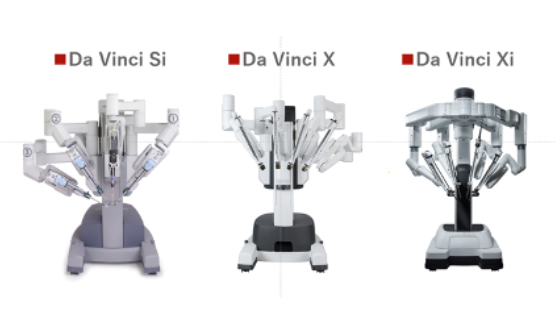
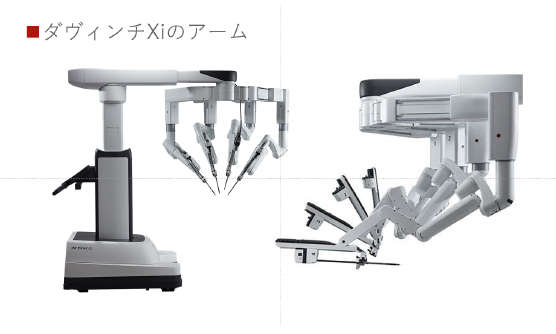
韓国、中国で国内に限って使用可能なロボットがあるのを除いては、ダヴィンチ以外に手術用ロボットは未だ登場しておりませんが、国内外で開発にしのぎを削っている状況で、2020年代にはいくつかの機種の登場が期待されます。
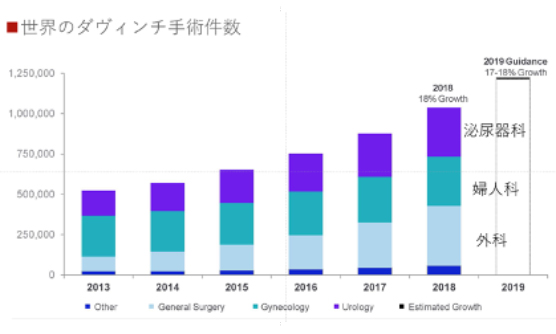
今後のロボット支援手術の展望
2年ごとに保険収載されるロボット支援手術が増えてきておりますので、近い将来、体腔鏡で行われているほぼ全ての手術がロボットで行われるようになると予測されます。国内外で新規ロボットの開発が進めば、価格競争によりコストの低下が期待でき、益々世界中でロボット支援手術が普及していくものと思われます。
さらに技術革新により、コンパクトなもの、アームが独立したもの、触覚やナビゲーションシステムをもったものなどが登場し、AIの導入により人間の手で操作しないロボットも開発されます。このように、ロボット医療は益々進化していくことが期待されます。
2020.4.16(文責)ロボット手術センター長兼泌尿器科部長
川喜田睦司
手術支援ロボット hinotori
手術支援ロボットhinotoriの導入
全世界におけるロボット支援手術には、ダヴィンチがほぼ独占状態でありましたが、2020年8月手術支援ロボットシステム「hinotoriTM」(図1)が、国産としては初めて製造販売承認を取得し、2020 年 9 月 1 日より泌尿器科において保険適用になりました。さらに2022年10月に消化器外科および婦人科にも保険適用が認められ、2022年末までに保険収載される予定です。本システムの名称「hinotori」は、日本を代表する漫画家で、医師でもあった手塚治虫先生が、命の尊さと向き合い、生涯を通じて描き続けた名著「火の鳥」より採用しています。
製造メーカーであるメディカロイドは、50年以上の歴史を持ち、産業用ロボットのリーディングカンパニーである川崎重工業株式会社と、検査・診断の技術を保有し、医療分野に幅広いネットワークを持つシスメックス株式会社の共同出資により、2013年神戸において設立されました。hinotorは手術に求められる術者の微細な動きを実現する手術支援ロボットとして開発され、“人の代わりとなる”のではなく、“人に仕え、人を支える”ロボット という考え方に基づいています。
手術支援ロボットhinotoriは、オペレーションユニット、サージョンコックピット、ビジョンユニットの 3 ユニットで構成されます(図2)。手術を実施するオペレーションユニットのアームはダヴィンチより多い8軸で構成され、人の腕のようになめらかに動き、アーム同士、清潔野の助手とのアームの干渉を軽減し、手術をスムーズに進めることに貢献し、より円滑な手術が可能となります(図3)。hinotoriの大きな特徴のひとつは、アームとトロカーのドッキングが不要であることで、トロカーの周りがすっきりとし、助手が動きやすくなり補助が容易になります(図4)。トロカーの挿入位置を記憶させ、そこを中心に動くことで、アームの動きで腹壁を損傷しないように設定が可能です。サージョンコックピットのモニターは、執刀医の好みの姿勢に手動で瞬時にあわせることができるように人間工学的な手法で設計されています(図5)。執刀医の負担を軽減し、ストレスフリーな手術をサポートします。ビジョンユニットは、 サージョンコックピットに高精細な内視鏡画像を 3D で映し出すとともに、執刀医と助手の医師との円滑 なコミュニケーションをサポートします。
当院では、2022年8月に手術支援ロボットhinotoriを導入し、同年11月より始動する予定です。現有のダヴィンチXi、Xに加え3台目となり、急激な症例数の増加に対応します。まずは泌尿器科の前立腺全摘除術から開始し、徐々にその他の術式にも拡大して行きます。
2022.10.25(文責)ロボット手術センター長兼泌尿器科部長
川喜田睦司
